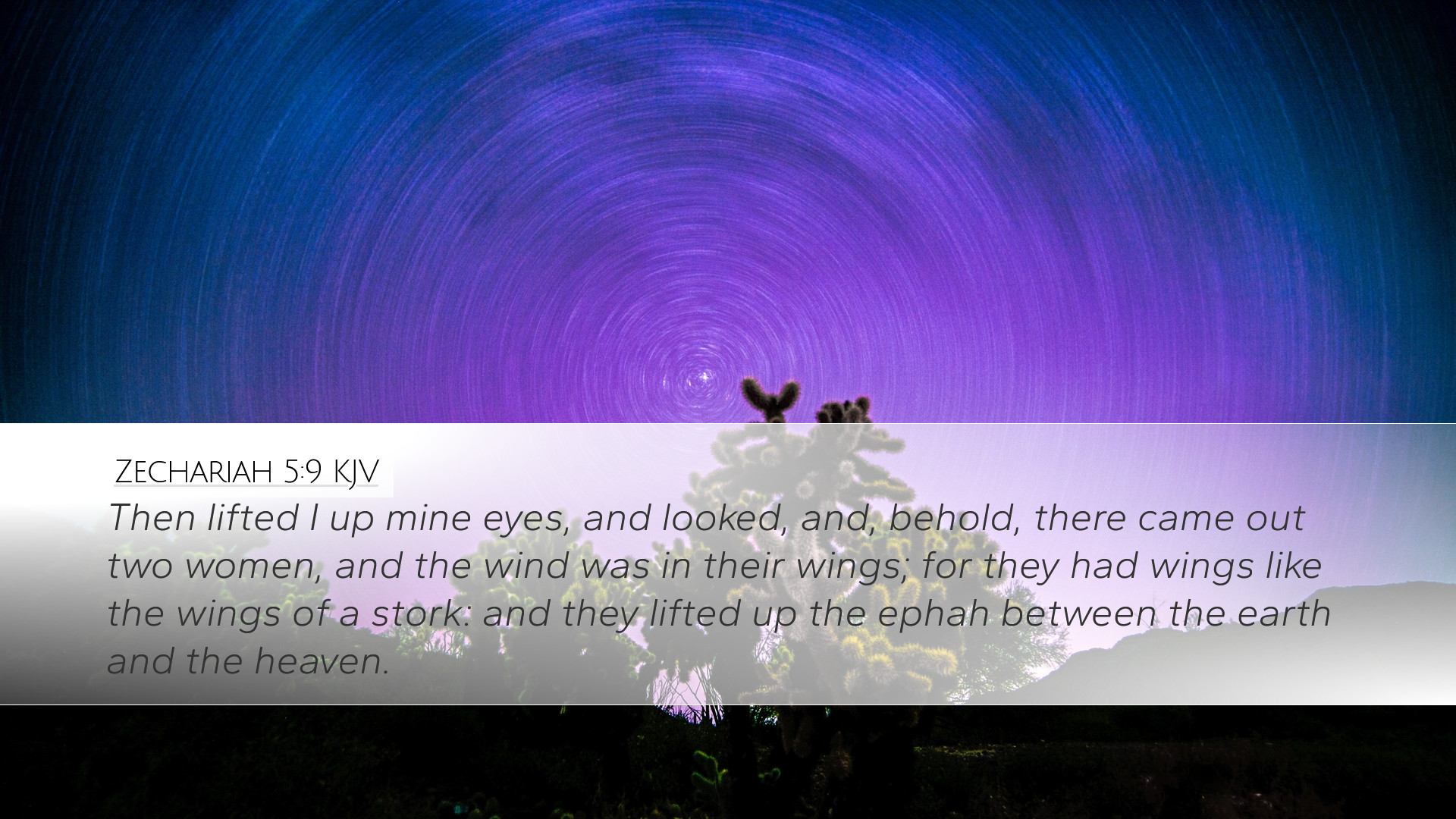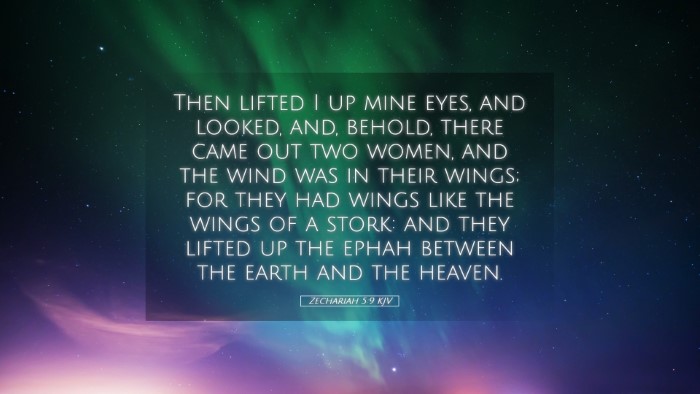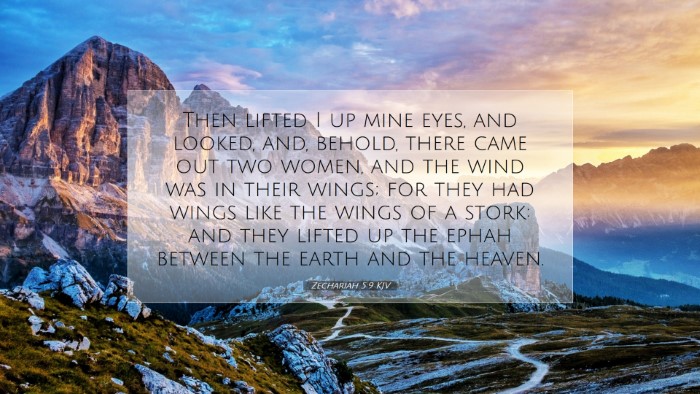Old Testament
Genesis Exodus Leviticus Numbers Deuteronomy Joshua Judges Ruth 1 Samuel 2 Samuel 1 Kings 2 Kings 1 Chronicles 2 Chronicles Ezra Nehemiah Esther Job Psalms Proverbs Ecclesiastes Song of Solomon Isaiah Jeremiah Lamentations Ezekiel Daniel Hosea Joel Amos Obadiah Jonah Micah Nahum Habakkuk Zephaniah Haggai Zechariah MalachiZechariah 5:9
Zechariah 5:9 KJV
Then lifted I up mine eyes, and looked, and, behold, there came out two women, and the wind was in their wings; for they had wings like the wings of a stork: and they lifted up the ephah between the earth and the heaven.
Zechariah 5:9 Bible Commentary
Commentary on Zechariah 5:9
Zechariah 5:9 states: "Then lifted I up mine eyes, and looked, and, behold, there came out two women, and the wind was in their wings; for they had wings like the wings of a stork: and they lifted up the ephah between the earth and the heaven." This verse introduces an intriguing vision that plays a significant role in the prophetic messages of Zechariah. Various public domain commentaries expand on the meanings and implications encapsulated in this passage.
Understanding the Context
The book of Zechariah, written during a post-exilic period, addresses the restoration of Israel and the reestablishment of the temple. The visions described throughout the book serve as visual aids to convey God's messages regarding the future of His people, the nature of sin, and the ultimate victory of righteousness.
Insights from Matthew Henry
Matthew Henry suggests that the two women symbolize forces or powers directed by God to accomplish His will. In his exposition, he notes that the stork is often associated with the idea of justice and righteousness, which stems from its role as a migratory bird with a strong tendency toward protective parental behaviors. The elements they are associated with—wind and wings—point to divine agency and speed, illustrating how God's judgment and restoration can swiftly come upon humanity.
Henry emphasizes that the ephah they carry symbolizes commerce and what people value, relating to the sins of the people. The act of carrying it between "earth and heaven" signifies God's interest in human affairs, bridging the heavenly realm with earthly existence. This emphasis on divine intervention highlights the necessity of vigilance in secular pursuits.
Insights from Albert Barnes
Albert Barnes provides a detailed exegesis of the imagery in this verse. He interprets the two women, their wings, and the ephah as representing a "wickedness" that is being carried away from the land of Israel. The wind in their wings suggests a divine breath, signifying the force of the Spirit of God directing them.
Barnes draws an important distinction between the transport of evil and the transport of divine righteousness, positing that the 'carrying away' of wickedness reflects God's ultimate desire to purify His people. He comments on the portrayal of the ephah as a container of weights and measures, traditionally holding grain or produce, thus symbolizing the economic and moral weight of sin that must be lifted from the community.
Insights from Adam Clarke
Adam Clarke's commentary adds another layer of depth, focusing on the symbol of the ephah in relation to the covenant community. He notes how women in biblical literature often bear significant meanings; here, they symbolize destructive elements of a society that turn individuals away from God. Clarke comments on the storks as a representation of ceremonial cleanliness, explaining that their role in the vision showcases God's intention to address and remove impurity.
Furthermore, Clarke connects the act of these two women lifting the ephah with the theme of judgment, suggesting that this vision serves as a warning of the eventual consequences of allowing wickedness to persist within a community. He accentuates the necessity of spiritual cleansing and the importance of pursuing holiness as foundational to receiving God's blessings.
The Theological Implications
Collectively, these commentaries illustrate the complex interplay between divine judgment, human agency, and the restoration of God's people. The imagery of the two women, their wings, and the ephah provides a profound visual to convey not just the removal of sin, but also the urgency with which God approaches the purification of His people.
Pastors and theologians can draw significant theological implications about God's sovereignty over sin and the transforming power of divine intervention. Understanding that God is actively engaged in addressing the wrongs of humanity reinforces the belief in His commitment to righteousness and justice, serving as both a comfort and a challenge to the faithful.
Practical Applications
- Awareness of Sin: The vision calls for believers to remain vigilant against the encroachments of sin, recognizing its potential to lead communities astray.
- God's Sovereignty: Emphasizing the belief that God is not passive but actively involved in the moral landscape of the world reinforces hope in His ultimate justice.
- Need for Restoration: Engaging with the narrative of cleansing should encourage personal and communal repentance, fostering a culture of holiness within the church.
- Understanding Purity: Clarke’s emphasis on cleanliness can lead to deeper discussions on spiritual purity and the holiness intrinsic to the Christian walk.
In conclusion, Zechariah 5:9 serves as a significant reminder of the workings of God in the lives of His people, the imperative to seek purity, and the profound assurance that He is devoted to removing wickedness from His creation. Those studying this passage are invited to reflect deeply on their own spiritual states and the collective state of the Church, seeking to align with God's will in both faith and practice.


